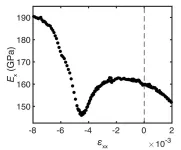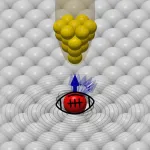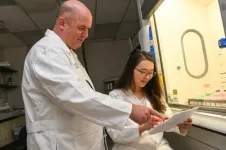(Press-News.org) While small, the hypothalamus – a complex structure located deep in the brain – plays a gargantuan role in coordinating the wide array of neuronal signals that are responsible for keeping the body in a stable state. In a Special Issue of Science, authors across four Reviews unpack this key brain region’s impact on physiological and behavioral homeostasis.
The hypothalamus consists of a complex collection of neural circuits. These circuits receive, process, and integrate sensory inputs to drive coordinated communication via a range of behavioral, autonomic, and endocrine pathways. These pathways support basic life functions, including regulating body temperature, hunger and thirst, mood, sex drive, heart rate, and sleep. In one Review in this issue, Harmony Fong and colleagues review the recent research that has elucidated the structural and functional complexity of hypothalamus. According to Fong et al., unlike other brain regions like the neocortex, which mediate complex functions across a relatively small number of neuronal fates, the hypothalamus is characterized by a far more complex cytoarchitecture comprised of potentially thousands of distinct cell types that form redundant, yet functionally discrete circuits. Recent advances in new methodologies, including single-cell RNA sequencing studies and modern photonic tools, have enabled high-resolution mapping of the hypothalamus’ complex circuitry. Deciphering these circuits is critical to understanding physiological homeostasis and behaviors, as well as the origin of many disease states. In another Review, Long Mei and colleagues discuss how the hypothalamus controls innate social behaviors. Mei et al. highlight the role of the reproductive behavior control column (RBCC) – a group of heavily connected neural circuits that are essential for all social behaviors, including sexual, parental, and aggressive behaviors. Here, the authors summarize recent progress in understanding how the RBCC integrates diverse hormonal, metabolic, and neurotransmitter signals to sustain social interactions that ensure reproductive success.
A third Review by Antoine Adamantidis and Luis de Lecea highlights the hypothalamus’ role in sleep, specifically the sleep neurons of the region that modulate control over opposing behaviors such as thermoregulation or goal-orientated behaviors during wakefulness. According to the authors, the neural substrates of wakefulness, rapid eye movement (REM) sleep, and non-REM sleep in the hypothalamus overlap both anatomically and functionally with cellular networks that support physiological and behavioral homeostasis. Finally, in the fourth Review, Garret Stuber describes what is known about the neural circuits that drive motivation. The nervous system coordinates various motivated behaviors that promote survival and evolutionary fitness, like eating and drinking and fight-or-flight responses. Although the behaviors that underly these actions are diverse, some features shared by all suggest common brain substrates are required for a range of motivational behaviors. Here, Stuber describes a framework that is useful for understanding these dynamics.
END
Special Issue: The hypothalamus
2023-10-26
ELSE PRESS RELEASES FROM THIS DATE:
A safer alternative to CRISPR-Cas approaches?: Retroelement-based genome editing tools
2023-10-26
In a Perspective, Stephen Tang and Samuel Sternberg discuss retroelement-based gene editing as a safer alternative to CRISPR-Cas approaches. Precision genome editing technologies have transformed modern biology. Capabilities for programable DNA targeting have improved rapidly, largely due to the development of bacterial RNA-guided CRISPR-Cas systems, which allow precise cleavage of target DNA sequences. However, CRISPR-Cas9 systems generate a DNA double strand break (DSB), which activates cellular DNA repair pathways that can lead to unwanted and complex byproducts, ...
UCLA researcher finds first proof of menopause in wild chimpanzees
2023-10-26
Key takeaways
Female chimpanzees in Uganda’s Ngogo community experienced a menopausal transition similar to women.
Fertility among chimpanzees studied declined after age 30, and no births were observed after age 50.
The data can help researchers better understand why menopause and post-fertile survival occur in nature and how it evolved in the human species.
A team of researchers studying the Ngogo community of wild chimpanzees in western Uganda’s Kibale National Park for two decades has published a report in Science showing that females in this population can ...
Conduction electrons drive giant, nonlinear elastic response in Sr2RuO4
2023-10-26
The hardness of materials is determined by the strength of the chemical bonds that are formed between the electrons of the neighbouring atoms. For example, the bonds in diamond are very strong, so it is one of the hardest materials known. The bonding is rooted in the laws of quantum mechanics, and the complex compounds that are of most interest in forefront research today are known as ‘quantum materials.’ In many quantum materials, layers of strongly bonded atoms separate layers in ...
New quantum effect demonstrated for the first time: Spinaron, a rugby in a ball pit
2023-10-26
Extreme conditions prevail in the Würzburg laboratory of experimental physicists Professor Matthias Bode and Dr. Artem Odobesko. Affiliated with the Cluster of Excellence ct.qmat, a collaboration between JMU Würzburg and TU Dresden, these visionaries are setting new milestones in quantum research. Their latest endeavor is unveiling the spinaron effect. They strategically placed individual cobalt atoms onto a copper surface, brought the temperature down to 1.4 Kelvin (–271.75° Celsius), and then subjected them to a powerful external magnetic field. “The magnet we use costs half a million euros. It’s not something that’s widely available,” explains ...
Researchers identify amino acid that may play a key role for predicting and treating long COVID
2023-10-26
University of Alberta researchers have identified an amino acid that may play a key role in predicting poor clinical outcomes and the treatment of long COVID.
In research published today in Cell Reports Medicine, the team says it has developed a predictive test to determine which patients with COVID-19 will go on to develop longer-term symptoms and proposes a clinical trial of an already-approved supplement as a potential treatment.
“This research helps us understand what’s happening in the bodies of people ...
UTHealth Houston researchers awarded $3.4M NIH grant to study pharmaceutical therapies to treat acute respiratory distress syndrome
2023-10-26
A four-year, $3.4 million grant to investigate molecular mechanisms and therapeutic treatments for acute respiratory distress syndrome (ARDS) has been awarded to UTHealth Houston researchers by the National Heart, Lung, and Blood Institute, part of the National Institutes of Health.
The study led by principal investigators Holger Eltzschig, MD, PhD, professor and chair of the Department of Anesthesiology, Critical Care and Pain Medicine at McGovern Medical School at UTHealth Houston, and Xiaoyi Yuan, PhD, assistant professor in the department, is built on many years of research in the endogenous ...
Renewed support for high power laser facilities will benefit discovery science and inertial fusion energy research at SLAC
2023-10-26
Research and technology development for plasma physics and fusion energy at the Department of Energy’s SLAC National Accelerator Laboratory just got a boost from a LaserNetUS award.
In total, the DOE’s Office of Science awarded $28.5 million to advance discovery science and inertial fusion energy, including a three-year grant for the development and operations of the Matter in Extreme Conditions (MEC) instrument at SLAC’s Linac Coherent Light Source (LCLS).
MEC has been home to high intensity laser experiments since 2012, and joined ...
TUM professor develops energy-saving AI chip
2023-10-26
The basic idea is simple: unlike previous chips, where only calculations were carried out on transistors, they are now the location of data storage as well. That saves time and energy. “As a result, the performance of the chips is also boosted,” says Hussam Amrouch, a professor of AI processor design at the Technical University of Munich (TUM). The transistors on which he performs calculations and stores data measure just 28 nanometers, with millions of them placed on each of the new AI chips. The chips of the future will have to be faster and more efficient than earlier ones. Consequently, ...
SETI Institute artist-in-residence Daniela De Paulis to receive 2023 Europlanet Prize for Public Engagement
2023-10-26
SETI Institute Artist-in-Residence Daniela De Paulis to Receive 2023 Europlanet Prize for Public Engagement
Daniela de Paulis is honored for her work bringing space and planetary science to international audiences.
October 26, 2023, Mountain View, CA -- The SETI Institute is thrilled to announce that Daniela De Paulis, a SETI Artist-in-Residence (SETI AIR), will be honored with the prestigious 2023 Europlanet Prize for Public Engagement. De Paulis’ groundbreaking project, ‘A Sign in Space,’ invited a global audience to participate in decoding a simulated message from an extraterrestrial ...
Genomic screening to identify iron overload encourages patients to seek treatment and condition management, study finds
2023-10-26
DANVILLE, Pa. – Genomic screening to identify hemochromatosis—a disorder that causes iron levels in the body to rise to dangerous levels—encourages people with the condition to seek treatment and ongoing management, a Geisinger study found.
Hereditary hemochromatosis type 1 (HH1), caused by a change in the HFE gene, is underdiagnosed, often resulting in missed opportunities for early and consistent treatment. Without treatment, hemochromatosis can cause iron overload, a buildup of iron that can damage many parts of the body. Treatment of hemochromatosis includes regular monitoring of iron levels and removing excess iron ...





